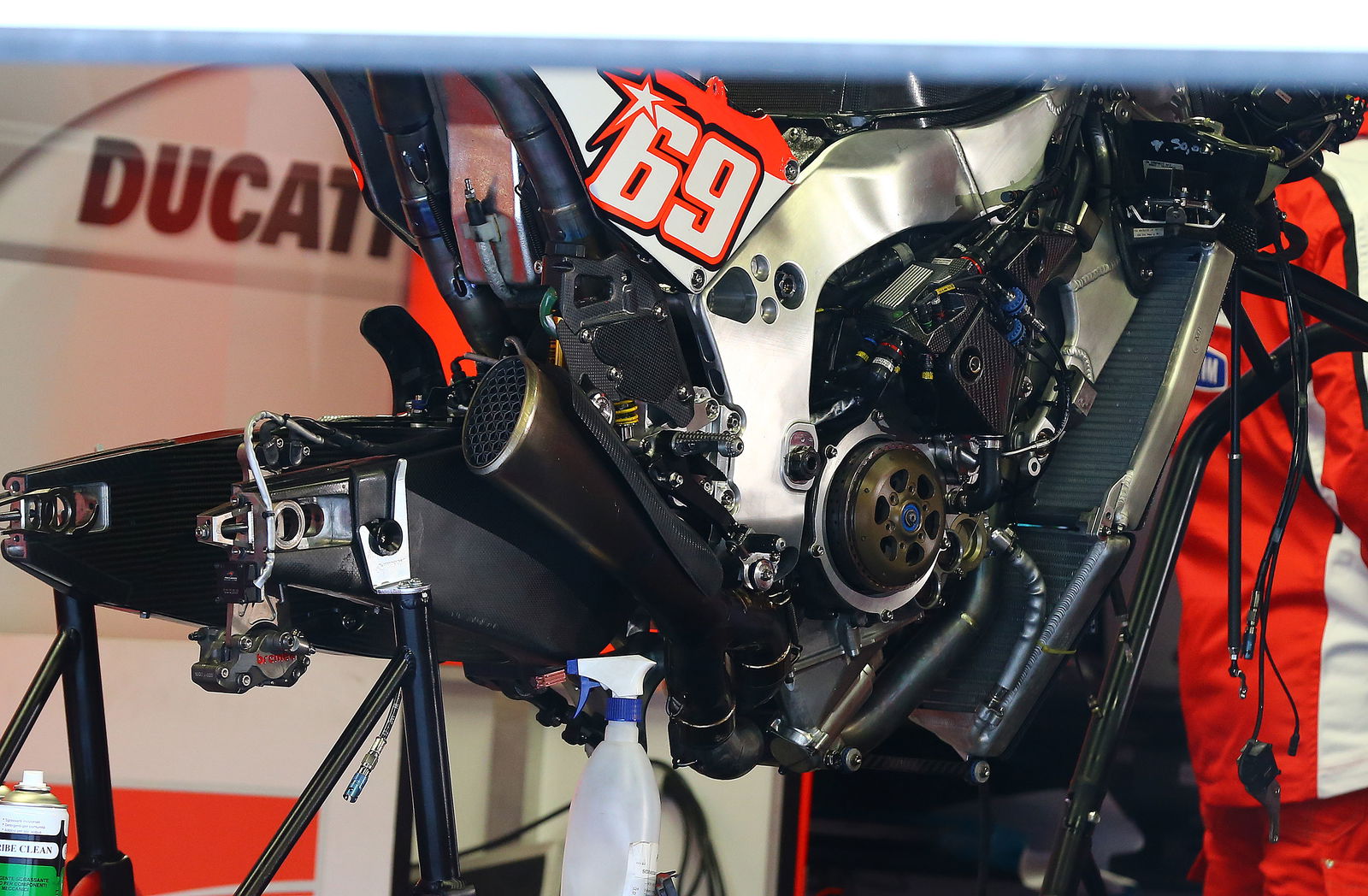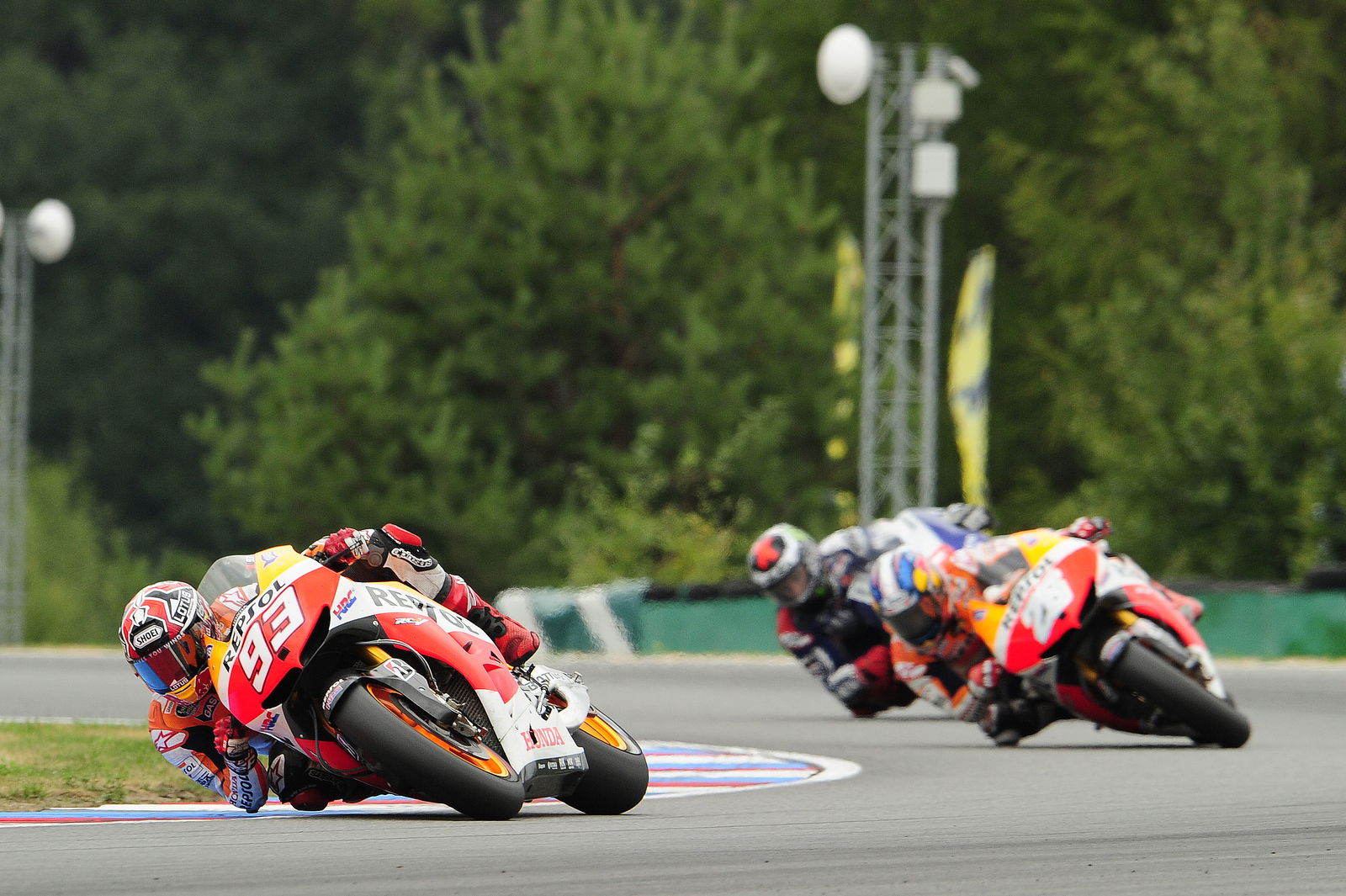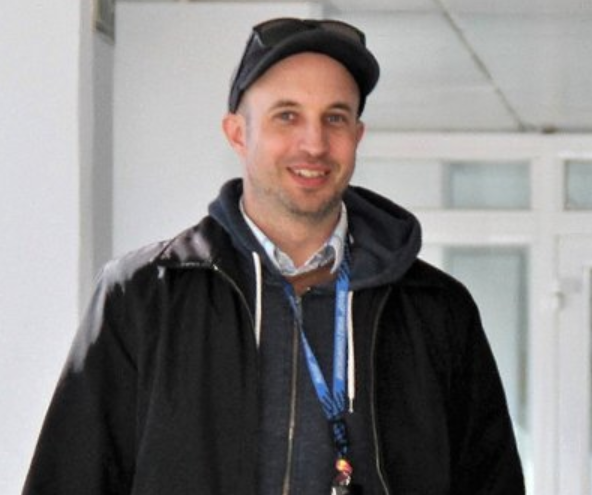Eskil Suter - Q&A

By Christian Tiburtius
An exclusive interview with Eskil Suter, head of Suter Racing Technology.
Suter is a constructor in all three grand prix classes - MotoGP, Moto2 and Moto3 - but has achieved its greatest success to date in Moto2.
Suter has won the Moto2 Constructors' title every year since the formation of the class in 2010, and took the riders' title last season with Marc Marquez.
However the top Suter rider, Dominique Aegerter, is currently fifth in the 2013 standings, with Suter currently second to Kalex in the Constructors' rankings...
Crash.net:
Are you an engineer or a racer?
Eskil Suter:
I was a racer for more than 35 years, I was in motocross for the first few years and then changed over to road racing. I did well in the European championship and then moved to grand prix racing.
I competed mainly in the 250cc class in '92 to '96. I wasn't bad in that in normal circumstances I'd be around P10 to P12 as long as everything went OK. I think my best placing was P5 at Assen in '95.
I stopped because we were starting to concentrate a little too much on the technical side of things because as a Swiss rider it was difficult to get factory material and we were forced to build our own. We started to concentrate a little too much on building engines and chassis parts and not so much on the riding as we really needed to do to succeed.
The fact that we spent so much time working on the technology side of things led me and my brother to the business we are in today. When I stopped racing we immediately set up Suter Racing and started to supply our former competitors with parts.
We are lucky in that our work and job is our passion, since I started working I have always thought motorcycles and been around them and that's something that is in my heart and blood.
Crash.net:
What proportion of your company is dedicated to motorcycle racing?
Eskil Suter:
Approximately 50%. We have various developments going on and also produce some parts for the defence industry.
Crash.net:
Is it true that motorcycle racing is illegal in Switzerland?
Eskil Suter:
It's not really illegal. The problem is that Switzerland is too crowded and we don't really have any race tracks to compete on. Also Swiss people like it calm and quiet! Every 500 meters there is always a small village or a house so you can't build a race track without disturbing existing infrastructure.
I think that road racing was made illegal at one time after a big crash in '56, but I don't think that that's in force any more. The main thing is that there are just no race tracks.
In Italy for example it's easier because even if you do build a race track near a house they might even enjoy a bit of racing noise, but here if you make too much noise you'd get shot!
Swiss people like it quiet, calm and green. As a motorcycle racer, it's perhaps not the ideal place, but the nice thing is that Switzerland is a very small place and we are surrounded by countries where there is great racing so we don't need to travel so far to get to the next circuit.
Crash.net:
When people refer to a Suter chassis in Moto2, what exactly do they mean?
Eskil Suter:
To simply refer to it as a 'chassis' doesn't reflect the reality of the situation. Other than the engine, we build every single part of it right down to the design of the throttle cable and the various bits and bobs you need to fully complete a motorcycle.
The only standard component is the engine which is supplied to us because it's a single make rule. Apart from Moto2 we also build complete engines. So in essence we make complete motorcycles.
For any customer we make what is called a rolling chassis kit, which means that we supply the whole motorcycle with the exception of the engine and sometimes without the suspension, brakes and wheels if the team has their own supplier contract for these.
At most, the receiving team will fit their own engine, wheels, suspension and brakes. If the team sends us the components they want to use, we can just supply the whole motorcycle fully constructed.
For private customers, which we also have, we usually supply complete motorcycles for track days. They're mainly constructed using second-hand parts from the world championship.
Crash.net:
So, would it be possible for a private individual to buy a full spec Moto2 motorcycle from you?
Eskil Suter:
Yes, no problems as long as you've got the money, it's no big deal.
Crash.net:
How much would a complete Moto2 bike including engine cost?
Eskil Suter:
I think between about 120,000 and 140,000 Euros depending on the detailed components used.
A complete Moto3 bike would be around 70,000 Euros
The motorcycle would come complete with the control ECU loaded with some default maps and would be ready to race. All you would need is fuel. This would be mainly for new teams, competitors in national championships or private track day bikes.
Normally though in the world championships, the teams are already well established which means that they will already have good stocks of components such as suspension, wheels and brakes, so they wouldn't buy every component new every year, we would just supply the parts they need. They would just replace damaged or worn out parts.
Even though the basic bike components will be exactly the same for all teams, we do have various options for various chassis parts such as linkage systems, triple clamps, steering inserts to change the castor angle, pivot height and things like that. So the frame and body components will come customised for a particular team. Normally to a private customer we sell the frame in a standard state.
Crash.net:
Wouldn't I need a laptop and a data engineer to get started?
Eskil Suter:
No, not really, you can run the bike without a data system like a normal Japanese bike when it's prepared for the track. You can just use the basic maps that come with the bike. For sure you won't get the last few tenths of performance, but you'll have a problem free run, the default maps are already very good.
The top teams will have the data and expertise to modify those to get the last crucial bits of performance.
Crash.net:
Does Suter provide support for teams at the actual race?
Eskil Suter:
There will be a few Suter engineers at every race to help the teams adjust their bikes to the track concerned. We have a good basic database for all the racetracks so are able to give good help with that. We'll have example set ups for each track that we can help the teams with. You'll often see Suter engineers in the team box during races.
They would also be there to collect information and to listen to any complaints or comments the teams might have so as to get information to develop the next chassis version. It's the comments of the race riders that give us the information and directions we need to develop the bike.
Teams such as Thomas Luthi's have already got huge experience with the bike regarding set-up though, so often work independently and don't need any input from us so our role will just be to evaluate the best compromise.
The Suter engineers will normally be assigned to two or three teams and will move around during practice, qualifying and racing as necessary.
This support will be part of the contract that the team has with us and the amount of support you can call on will depend on which contract you have. Contracts wouldn't include damage repair as this would be taken care of by the teams themselves.
We will have a service truck at the races with a good stock of spare parts that will allow teams to repair as necessary if they run out of their internal small stock of spares. The service truck will be able to supply any parts from a full chassis to a water hose.
In the early years I went to every race but now I go to every second race or so. Nowadays we have about 35 employees who we can rely on, but it's always interesting to actually be there to feel the atmosphere.
Crash.net:
How is the chassis developed?
Eskil Suter:
Originally we built up a pretty huge database from other racing motorcycles we were involved in with information such as stiffness, flexibility, engine position and centre of gravity so had the theory to start in a good place.
We then did our own tests to make sure that the theory was sound and from there changed things taking the directions to go from rider comments.
The original test rider we used to develop the [Moto2] bike was Roby Rolfo and some other Spanish riders in 2008 and Roby did a very good job for us.
In the first two years of Moto2 we did a lot of our own testing, but now we are at a level that our own testing can't give us the kind of extremes of information that we need. If you go with what Thomas Luthi is telling you, then you can be sure that you are getting information relevant to the pinnacle of racing whereas a test rider may not push things right to the limit.
With the standardisation in Moto2, it means that we are really just fine tuning things to get those last hundredths so need the kind of input a professional race rider can give us. In the first few years we could find pretty big improvements by changing a swingarm or chassis geometry but now we are really just fine tuning.
One of the major areas of improvement is also in streamlining and we usually have two or three sessions per year in the wind tunnel.
Even today though, we still test major new components to get improvements, it's just that our experience means that we get it right from the start.
Crash.net:
Do you listen to one rider more than another, for example was development done with Marc Marquez in mind last season?
Eskil Suter:
No actually not, we have quite a lot of riders using Suter on track and usually go with a majority opinion. If you've got ten riders on track and seven are saying one thing, then that's probably the best direction to go in. It's not a good idea to listen to just one rider because they can lead you in a dead-end direction. It's a pretty democratic system.
We supply everybody with the same equipment at the start of the season and it's up to them which direction they go in. If we have a new component in the meantime then we supply it to all the teams. If the component is only available in limited quantities though then we'll supply them to the teams in the best championship position first.
Our lead riders are probably Thomas Luthi, Johann Zarco and the two guys from Aspar [Terol and Torres], but at the beginning of the season we had the biggest expectations for Thomas Luthi and his test speed showed that he would have been able to fight for the title if he hadn't been injured.
Crash.net:
Do you keep examples of your competitor's frames for reference?
Eskil Suter:
At the moment there are probably only three competitors in Moto2 and I think that we all work in a fairly similar way. We don't have rivals products in our workshop because of course someone like Kalex will try to avoid that at all costs, and so would we.
I don't think that's the way to go anyway because you need to have your own philosophy and development path and if you start to try to copy things from someone else you can have a mix of ideas and that probably isn't the best way to progress. I don't think that examining and copying competitor's stuff is a professional way to work anyway.
Crash.net:
You were the Moto2 Constructors' World Champions in 2010, 2011 and 2012, why are things not looking so good this year?
Eskil Suter:
Yes, we were world champions in the first three years and this year looks a little more difficult, particularly because our number one rider had a bad injury at the beginning of the year.
There hasn't been a change in Kalex or Suter which has caused this. It's mainly up to the teams and riders because at this stage of development the difference between us and Kalex is very small and any difference you see will be due to the rider and crew.
Crash.net:
How would you compare your bike with the Kalex?
Eskil Suter:
I've seen it and I would say that we are both working in a similar way, but we have our own philosophies. They are very similar, but it may be that our bike is a little smaller because the Swiss are smaller than the Germans!
Our frame was developed for the normal size of a competitive rider in the intermediate class, which is a maximum of 170cm tall and 55-60kg weight. You have to design your bike around this size because it's these riders who are becoming world champions. There can be exceptions like Valentino Rossi who was slim and light but also quite tall and for such a rider you may have to make some adjustments or make some different components.
Crash.net:
Given the problems that some larger riders have had on the Suter, would it be possible to design a bike in different sizes or adjustable?
Eskil Suter:
No, not really. You usually adjust the size of the bike by moving the seat unit, tank, footrest and handlebars anyway. I've never known a manufacturer have a fundamentally different frame for different riders.
Like I said the normal competitive rider is around the size of Marc Marquez so that is the size we design for. It doesn't make any sense designing a bike for exceptions like Scott Redding or Valentino Rossi.
From that point of view these kind of exceptional riders have a clear disadvantage in the smaller classes. On the 125s you would never be able to become world champion if you were over 70kg, it's just impossible.
Luckily that disadvantage disappears in MotoGP where the bikes are, let's say, overpowered.
Crash.net:
When you watch a race, do you support the motorbike or the rider?
Eskil Suter:
In the paddock it's like a big family, you will have a lot of friends there and you will have your favourite riders. Motorbike racing is mainly connected to the rider rather than the brand. If I had to hire three riders for a hypothetical team I would go for Pol Espargaro, Thomas Luthi and Domi Aegerter.
I think we can expect great things from Domi for next season - he's getting stronger every year. Normally in Moto2 you need one year to get the hang of things and then you can be competitive, but then you can have a rider like Marc Marquez...


